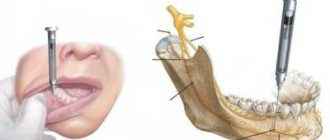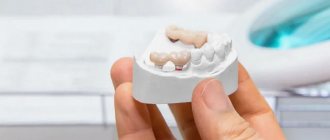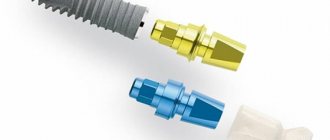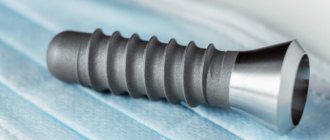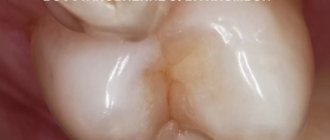26.11.2019
Today, there are often situations when, after dental treatment, a filling interferes with the patient. Although during the process of filling and correction the dentist carries out all the necessary manipulations so that the material does not seem like a foreign body, it is not always possible to do everything perfectly. The problem is fraught with impaired chewing function and improper closing of the jaws. You should study in detail the symptoms and causes of this phenomenon, and also figure out how the patient should behave in such cases.
Symptoms of an incorrectly placed filling
Very often, patient complaints about discomfort after installing a filling have nothing to do with improper manipulation or excess materials. This often happens when most of the tooth has been destroyed and the patient has become accustomed to the emptiness. Consequently, after filling, a false feeling of discomfort appears, which is caused by an unusual feeling of fullness in a place that has been empty for a long time. In such situations, you need to wait a little - often within a few days a person gets used to the new sensations, and the installed filling ceases to cause discomfort.
First of all, you need to figure out how to understand whether the discomfort is associated with the adaptation period, or whether the unpleasant sensations are a consequence of the doctor’s incorrect actions.
There are several symptoms indicating improper installation of filling material:
- On the side of the tongue, in the place where the product is installed, pain is felt or there is a wound.
- During chewing, discomfort is replaced by a feeling of pressure or pain.
- After a visit to the doctor, the patient experiences articulation disorders - slurred pronunciation of sounds.
- When you try to compress your jaws, the presence of foreign material prevents you from doing so.
If at least one of the above-described signs appears, we can say that the structure requires additional polishing.
Indications for use
The use of bite pads is not limited to teeth correction with braces. In childhood, they are able to replace baby teeth that have fallen out or been removed prematurely. They are used to correct minor deviations in the structure of the dentition in adolescents, if the severity of the defect is insignificant.
Simultaneously with the brace system, the devices are used for the following purposes:
- reducing the risk of teeth touching individual elements of the system while chewing food;
- eliminate discrepancies in jaw size due to crossbite;
- protect soft gum tissues from damage by teeth during deep bites.
The duration of wearing overbite fillings does not correlate in any way with the duration of the entire orthodontic treatment. They are replaced or removed immediately after intermediate therapy goals are achieved.
Causes
The main reason for the appearance of the symptoms described above is an excess of filling materials and inaccurate formation of the surface of the restored unit. Because of this, the surface of the tooth becomes slightly higher than necessary for proper closure of the jaws.
The qualifications of the specialist who performed the filling procedure are not always the cause of the problem. Often, local anesthesia is used during the installation of fillings, so the patient may not accurately describe his sensations when the specialist asks him to describe the sensations after the final polishing is completed. As a result, after the medication wears off, discomfort appears that was absent when you were in the dentist’s chair.
In some cases, the source of discomfort may be the inflammatory process of the periodontium, due to a violation of the stable position of the dental unit. Almost imperceptible tooth mobility can disable the mechanism of closure of the upper and lower jaw. But before the filling was carried out, the missing part of the unit compensated for the defect. Accordingly, after complete restoration of the size and shape of the tooth, the disease manifests itself in full.
Another cause of discomfort can be tooth misalignment. Often this symptom appears after filling a gap between teeth or removing a unit in the same row. Complaints that the filling is in the way appear several months after installation. The missing unit causes the remaining teeth to shift towards the empty space, so when they are closed tightly, unpleasant sensations appear.
A common cause can also be an excessively thin wall between the pulp chamber and the product. Because of this, the pressure that is applied to the filling during chewing is transferred to the bottom of the chamber and irritates the dental nerve. In such cases, the cause of the unpleasant sensations lies inside the dental unit, but is felt as a structural defect.
Criteria for determining a good filling
Conventionally, materials for treatment are divided into 2 main groups: cement and composite. The former are gradually fading into the background; they are not used so often. Composite analogues have many advantages, high strength characteristics and are safer to use.
Good fillings are determined by the following criteria:
- The correct chewing surface has been restored. Each tooth has its own shape; there may be cusps, pits, and fissures (natural grooves in the enamel). During caries, hard tissues are destroyed. When a dentist applies a filling, his task is to restore all the nuances of the surface, otherwise the effectiveness of the tooth will be low. That is, without grooves and bumps, it will not be possible to grind food, which is necessary for healthy digestion. The first sign of a good filling is the absence of smoothness on the chewing surface.
- Dense and precise contact point. Violation of this criterion threatens repeated caries and gum injuries. In dentistry, a contact point is the place where adjacent teeth come into contact. Improperly restored junction leads to accumulation of food and can cause destruction of the alveoli and other problems. If the gap between the teeth is visually determined or the floss thread is easily inserted, it means that the filling was performed poorly.
- No obvious defects. Voids, microcracks, overhanging edges are signs of illiterate treatment. Such fillings will not last long. In addition, food debris will accumulate under the overhanging edges and cannot be removed with a brush or thread.
Another difference between a good filling and a bad one is that the shade of the restored surface matches the natural color of the tooth. In this case, it is impossible to determine by eye the boundary between the material used and natural enamel.
Norm or pathology
Let's consider the options for normal and pathological conditions, in which you should immediately consult a dentist.
Is it worth going to the doctor?
It is unlikely that you will be able to correct the situation on your own without qualified help. Therefore, if the filling interferes, you need to contact your dentist.
Many people, when faced with such a problem, try not to pay attention and wait for the material to erase itself. This opinion is erroneous, since modern dental preparations used for filling have high strength values. Therefore, it can take years for abrasion to occur.
The opinion regarding shrinkage over time is correct, but until this happens, a significant period of time may pass. It is impossible to get used to unpleasant symptoms, and keeping the jaw in this state for a long time can lead to negative consequences.
Manufacturing and installation algorithm
Platforms are made based on an impression of the patient’s jaw. To facilitate their removal in the future, bite fillings are made from materials that are significantly different in color from the color of the enamel. After the devices have completed their task, they are removed using a drill.
During operation, seals often require replacement. There may be some discomfort immediately after installation. However, if the degree of discomfort associated with the presence of a “gasket” between the teeth does not decrease over time, it is necessary to consult a doctor and undergo correction.
Home treatment methods
As mentioned above, it is impossible to get rid of the problem at home, and it is unreasonable to expect natural abrasion of the material.
To alleviate the condition before visiting a specialist, you need to follow certain recommendations:
- Avoid eating hard foods that require biting. The sealed unit, due to its higher location, is subject to the main load, and this is fraught with a fracture of its base.
- Eliminate hot foods from your diet. This is because such foods and drinks can cause swelling of the soft tissues, increasing the discomfort.
- For severe pain, analgesics or non-steroidal anti-inflammatory drugs can be used. However, you should not abuse such drugs, because their use is limited - no more than 5 days.
What will the dentist do?
First of all, the doctor will perform repeated manipulations to process the product using a copy napkin. After applying it to the tooth, the patient will need to clench his jaw tightly. The interfering area is determined by the imprints left on the surface of the unit.
If the cause of the pain is periodontal disease, a periodontist is involved in the treatment process, who, together with the therapist, works to eliminate the problem.
In some cases, removal of the filling may be indicated. After preparing the dental unit, medicinal substances are placed in it, as well as an insulating lining. Then a temporary filling is installed and the patient is sent home. If after a second visit the dentist notices an improvement, a permanent product is installed.
It is also important to remember:
You should not ask the dentist to “cut down” the filling too much in advance to avoid possible overestimation. The upper and lower teeth must be in contact with each other to ensure proper chewing of food. In addition, the removal of teeth from the bite (a special reduction in their height) can lead to a decrease in the distance between the upper and lower jaws. This will inevitably lead to the same diseases of the temporomandibular joint. Therefore, the height of the fillings should be optimal, comfortable for the patient, and at the same time, not reducing the height of the bite.
Remember!
If after installing the filling (coming home, the next day or some time later) you notice that the filling is bothering you and you feel uncomfortable closing your mouth, then if possible, contact your dentist. He will once again check the contact points of the teeth using a carbon copy, find out your subjective sensations (where, in your opinion, it is interfering) and adjust the filling. It will take literally 5-10 minutes and will save you from further problems.
In addition, if you feel that the edge of the filling is sharp and injures the surrounding tissues (tongue, cheek, gum), that the filling is not polished enough, that there is a gap, gap, step, etc. between the filling and the tooth. – also consult a doctor for correction. If there are undercuts, gaps and roughness, there is a risk that plaque and microbes will accumulate under the filling or on it, and a relapse of caries may develop in this place over time. The dentist will quickly and painlessly polish the problem area and thereby prevent possible consequences.
Possible consequences
If the installed filling material interferes with the full closing of the mouth and jaw closure, this is fraught with side effects for the patient.
The consequences may be as follows:
- Pressure on antagonist teeth. If the product is not installed correctly, the adjacent teeth will exert constant pressure on the filled unit. It can provoke periodontal trauma and the development of secondary caries.
- Formation of cracks and chips on the surface. Excessive pressure can not only cause injury, but also lead to chipping. In addition, weak tooth walls can break off along with the filling.
- Dislocation of the jaw. Incorrectly installed elements can cause insufficient jaw closure. Misalignment of one part in relation to the other will lead to dislocation.
Why is an over-inflated filling dangerous?
- Due to an incorrect filling, the tooth will experience constant stress, which can lead to inflammation of the pulp, which will have to be removed in order to avoid complete removal of the tooth.
- Also, due to increased stress, the filling and tooth wall may crack.
- An oversized filling prevents the jaw from closing evenly when closing the mouth. Accordingly, one of the sides of the jaw will be at a different level relative to the second side. Over time, such distortion will become a habit and the person will not pay attention to it, however, this does not mean that such a situation is the norm. Ultimately, improper jaw position will lead to various temporomandibular joint diseases.
Expert advice
The arrangement of teeth in a row was initially determined by nature, so the elements must touch correctly for the full implementation of the chewing function. A change in the bite can cause an incorrect distance between the jaws. Once such a pathology develops, it will be much more difficult for the doctor to eliminate it.
To minimize the likelihood of complications, the patient must take certain actions himself. If bite defects are observed within a few days after installing the composition, you should immediately consult a dentist. Correcting the filling will take a few minutes, but these manipulations will help prevent the development of disorders.
After installing the material, some people complain about roughness and stepped placement of the composition. Pathogenic microorganisms can accumulate in the formed cavities, which will lead to the development of secondary caries. In such cases, it is also necessary to urgently visit the dentist's office.
Category Dental filling Posted by Mister stomatolog
What to do if a temporary filling falls out
The material of permanent fillings can be destroyed under the influence of applied force. Temporary material is not designed to withstand loads at all; it is very fragile, soft, and easily chips. As a rule, such fillings are installed for a short period between visits to the dentist. For example, after treatment and filling of canals before installing a permanent filling. Its function is to prevent saliva and food from getting inside the tooth.
If a filling falls out, it is better to inform the doctor about it, the specialist will tell you whether it is worth coming for an unscheduled appointment or whether you can wait for the scheduled visit.

